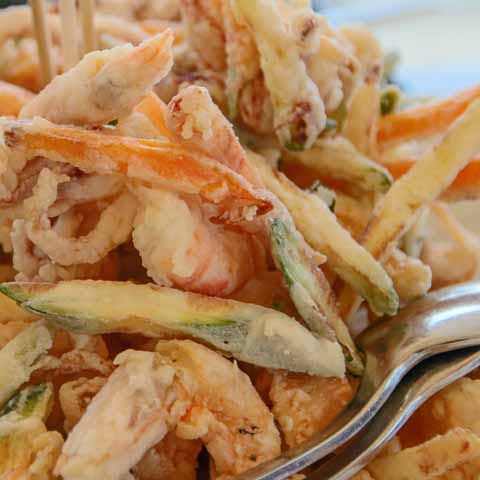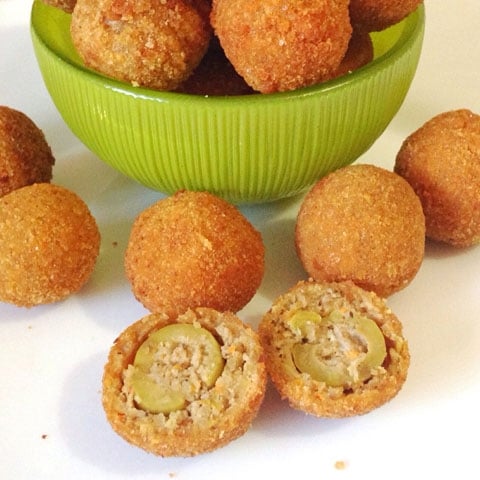Marche, Italy is one of twenty regions in the country, but perhaps one of the few that offers a deliciously atypical cuisine from the rest of the country. Influences of Tuscany, Lazio, and Emilia Romagna cuisines combine with Marche’s Italian roots to yield a truly unique dining experience that intermingles foreign cooking methods with local products and traditions. The result is quite simply a distinctive cuisine that is considered to be one of the best kept secrets of Italy.
The region is perhaps best well known for one if its delicacies that is a tried and true staple, the truffle. In general, a truffle is a fragrant fungus growing in heavily wooded areas that is thought to be a culinary delicacy in Europe. While both white and black truffles are frequently requested and served in Marche, a specialty white truffle from Acqualagna is by and large the most celebrated. The oak forests of this town in particular are renowned for this highly sought after truffle as well as a robust crop of mushrooms that is a key ingredient for local dishes.
Vast olive groves blanket the region’s hillsides, making it one of the premier olive oil producers in Italy. The Olive Ascolane from the Ascoli Piceno area appear larger and are more savory in taste than its Italian cousins. These particular olives are a crucial ingredient in a prized local recipe known as Olive all ‘Ascolana, a meat-stuffed olive that is both breaded and fried. This appetizer is recognized globally as one of the best finger foods for a truly Italian aperitivo, or light drink or meal consumed at the end of the day an hour or two before dinner.
APPETIZER/ENTRÉE
The star of the show when it comes to appetizers in Marche is without a doubt the Tagliere, a wooden tray stocked with an assortment of toasted crostini, savory cheeses, and cured meat. Specific to Marche, an order of Tagliere can include several rich local favorites, including salted and spiced cuts of pork loin salami called Capocollo, seasoned pork loin dressed with black pepper and herbs known as Lonza or Lonzino, a spreadable minced pork salami titled Ciauscolo, selected cuts of Italian pork seasoned with spices and wine called Salame di Fabriano, and Prosciutto di Carpegna.
Consumption of Prosciutto di Carpegna dates as far back as the fifteenth century and has more recently obtained the title of Protected Designation of Origin. The designation means that the pigs used in the production of this particular prosciutto can only be from Marche, Emilia Romagna, and Lombardia. Prosciutto di Carpegna is recognized for its unique rounded and flattened shape with some white fatty accumulations that enhance the flavor.
FIRST COURSE
Mealtime in Marche is a lesson in leisure that includes good food, close companionship, and much laughter.
A specialty first course specific to the region is Vincisgrassi, a special lasagna with ingredients of chicken livers, hearts, sweetbreads, and pancetta. The dish can also include duck, veal, or lamb as a replacement for beef if preferred. The finishing touch is to top the meal with sprinkles of truffles or mushrooms to bring the dining experience to a completely different level. The Lasagna Emiliana is a renowned version of this lasagna, adding a unique twist with a mouthwatering meat sauce that makes it a staple for dining establishments in the area.
Those looking for lighter fare may be drawn to brodetto, a popular tomato-based fish stew. The soup is a specialty of Marche, often served with variations depending on the town you are dining in. The dish came into existence via humble peasants that incorporated seafood scraps not sold by local fishermen into the soup. Of all the variations of brodetto, by far the best known and most popular is the traditional Brodetto all’Anconetana. This version of the soup, originating in Ancona, contains at least thirteen different types of fish and seafood from the Ancona Sea.
SECOND COURSE
Pace yourself throughout the meal, taking time to savor and linger over each dish before the next arrives. Second course choices offer some of the most distinguishable cuisine you will see on the table.
In Marche, frying is considered to be a culinary art so it is no surprise that fritto misto, a traditional mixed fried platter, is a popular second course. Fritto Misto all’ascolana is a variation of this recipe comprised of Olive All’Ascolana, fried artichokes, fried zucchini, and fried lamb.
Chicken is frequently a second course, but the method in which it is prepared varies greatly. A few of the more requested dishes are Pollo Alla Moda di Macerata, Pollo in potacchio all’anconetana, Petto di Pollo tartufato, Pollo in graticola with spices, and Pollo nel coccio. Locals and tourists alike are often drawn to Pollo ‘ncip ‘nciap, a dish originating in Offida of the Ascoli Piceno province, consisting of chunks of browned chicken cooked in white wine, lard for flavoring, and fresh rosemary.
SIDES
Savory, robust cheese is the main attraction when it comes to side dishes in Marche.
Ambra di Talamello is an Italian cheese originating in Marche that later was produced in Talamello, Italy. It is a kind of Formaggio di Fossa, or cheese aged underground. Ambra di Talamello is wrapped carefully in cloth and aged in tufa limestone pits that are lined with cheesecloth and hay on the bottom. This particular cheese ages for several months, during which it develops a mold and ferments, giving it a distinctly sharp flavor that compliments the amber coloration.
Casciotta di Urbino is a semi-soft cheese native to and only be made in the Pesaro-Urbino province of Italy. This Italian cheese is made from seventy percent sheep milk and thirty percent cow milk. Casciotta di Urbino is deeply rooted in tradition, with the cheese’s production traced back to the times of the Dukes of Montefeltro.
DESSERTS
The savory culinary delights of the traditional Marche meal are best followed by lighter, sweeter fare that delights taste buds and satisfies sugar cravings.
Ciambellotto con i funghetti all’anice is a popular family dessert always found on Marche dinner tables during important events and holiday festivities. The cake is ring-shaped and is somewhat typical in texture but flavored with aniseed which gives it an amazing aroma.
STREET FOODS
While traveling the streets of Marche, there are several street foods not to be missed. One of these Italian culinary treats is Porchetta. The dish is made from a whole de-boned pig that is filled with herbs such as wild fennel and rosemary and then slow roasted. The meat is primarily sliced and served in between two pieces of bread or is simply eaten like a steak.
Another popular street food that often doubles as an appetizer is Olive All’Ascolana. These olives are stuffed with a mixture of chicken, veal, pork, and seasoning sautéed in butter, Parmigiano, and nutmeg. While not common, some vendors offer a variation of this dish in which the olives are stuffed with fish rather than meat.
WINES
To dine among some of the finest eating establishments in Marche without trying the region’s homegrown specialty wines simply makes the experience woefully incomplete.
More than two-thirds of Marche, Italy is part of the Apennine Mountain Range with the remaining third consisting of rolling hillsides perfect for growing grapes. For quite some time, the region’s wines were not recognized beyond its borders, but that perception is quickly changing.
Today, Marche is considered one of the fastest growing areas for wine and wine sales. Verdicchio is the region’s most well-known white wine, while the most renowned red wines are Rosso Conero and Rosso Piceno.
Rosso Conero is the leading red wine of Marche, produced primarily from the Montepulciano grape grown on the hillsides of Monte Conero. The vineyards provide a simply stunning backdrop to the sparkling blue expanse of the seaport of Ancona.
Rosso Piceno, also a red wine of the region, has a larger production than Rosso Conero and is Marche’s largest volume red wine, second only to Verdicchio dei Castelli di Jesi. The popular red is comprised of Sangiovese grapes, Montepulciano grapes, and up to fifteen percent of Trebbiano and Passerina white wines.


